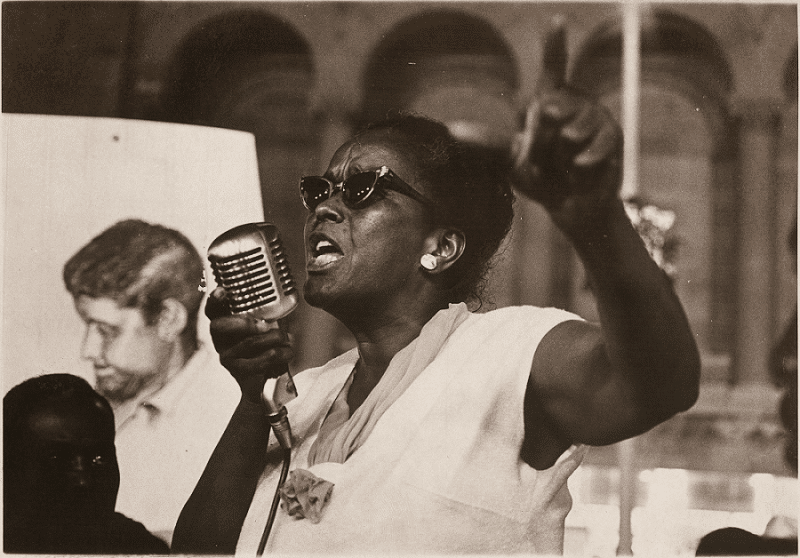Bigger than a Hamburger
Lesson by Maggie Nolan Donovan
Ella Baker and other delegates challenge Mississippi Democrats, 1964. Photo by George Ballis. Collection of the Smithsonian National Museum of African American History and Culture.
The Southern Leadership Conference made it crystal clear that current sit-ins and other demonstrations are concerned with something much bigger than a hamburger or even a giant-sized Coke.
Whatever may be the different approach to their goal, the Negro and white student are seeking to rid America of the scourge of racial segregation and discrimination not only at lunch counters, but in every aspect of life.
— Ella J. Baker, Southern Patriot, May 1960
Grade Level: 1st-2nd
Time Required: One class period
Objectives
Students will consider the broader goals of the Civil Rights Movement
Enrich language experiences as they consider symbol and metaphor
Activity Description
“A hamburger is such a little thing,” exclaimed 7-year-old Hannah during a discussion about sit-ins. She was expressing her surprise and annoyance at so much fuss, so much hostility and resistance, to someone ordering a hamburger. I reminded her that the issues behind the sit-in movement were, in Ella Baker’s words, “bigger than a hamburger.” She nodded, as did most of the children sitting in a circle with her.
We had discussed the layered nature of sit-in goals several times before, and children understood that the students at the lunch counters wanted both a hamburger and racial justice. They knew that Ella Baker is a figure of central importance in the Civil Rights Movement. They were familiar with her work for the NAACP and as an advisor to the students who sat in and later formed the Student Nonviolent Coordinating Committee. She is one of many figures from the Movement whose voices are heard in our classroom. Ella Baker’s words, and Hannah’s, resonated with me as I thought about another way to help students respond to sit-in stories. I suggested we make a hamburger bulletin board. Its purpose would be to explore what ideas might be bigger than a hamburger. I drew a large burger in a bun — complete with cheese, lettuce, tomato, and onion — and made copies for everyone. I cut up strips of oak tag for students to write on. Children colored and cut out the burgers and then wrote on the oak tag strips their ideas of what’s bigger than a hamburger. Each child stapled a strip over the hamburger. We made a big display across the back wall of our classroom.
Among the words the children wrote were:
freedom
justice
equality
joy
peace
happiness
love
When the bulletin board was complete, we sat beneath it as we discussed why we had chosen certain words, why those words are still important, and what they meant to us. We wanted people passing through to ask the meaning of our display, and they did. The 1st-graders deepened their own understanding as they answered the visitors’ questions and quoted both Hannah and Ella Baker on the size of a hamburger. Playing with size and making things bigger are two experiences that deeply engage young children. Linking size to sit-in stories allows them to explore Movement history and their own ideas and fantasies about power. It also enriches their language experiences as they consider symbol and metaphor. I am pursuing my own size fantasy by realizing that I can make those paper hamburgers a whole lot bigger. Next year I plan to introduce giant burgers, really big strips of paper covered with huge words, and an enormous display that may spill out of the classroom and into the corridor. “These ideas are big,” we’ll be saying. “They are powerful. They must be struggled for. The struggle continues.” ■


